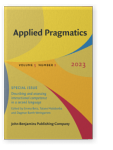Discussion
L2 interactional competence and assessment
Insights and challenges – a discussion paper
Article outline
- 1.Introduction
- 2.A bit of historical background
- 3.Conceptualizing interactional competence and challenging existing descriptors
- 3.1Epistemologies of language learning, descriptors, and reference frameworks
- 3.2Refinement of descriptors, operationalization and practicality
- 4.Some personal thoughts in conclusion
-
References
References (16)
References
Firth, A. & Wagner, J. (1997). On discourse, communication, and some fundamental concepts in SLA research. The Modern Language Journal,
81
(3), 285–300. 

Garfinkel, H. (1967). Studies in ethnomethodology. Polity Press.
Hymes, D. (1972). On communicative competence. In J. B. Pride & J. Holmes (Eds.), Sociolinguistics (pp. 269–293). Penguin.
Kramsch, C. (1986). From language proficiency to interactional competence. The Modern Language Journal,
70
1, 366–372. 

Levinson, S. C. (2006). On the human “interaction engine.” In N. Enfield & S. C. Levinson (Eds.), Roots of human sociality: Culture, cognition and human interaction (pp. 39–69). Berg.
McNamara, T. (1997). ‘Interaction’ in second language performance assessment: Whose performance? Applied Linguistics,
18
(4), 446–466. 

Nguyen, H. T. (2019). Deepening roots and broadening horizons in interactional competence research and praxis. In M. R. Salaberry & S. Kunitz (Eds.), Teaching and testing L2 interactional competence: Bridging theory and practice (pp. 397–412). Routledge. 

Pekarek Doehler, S. (2019). On the nature and the development of L2 interactional competence: State of the art and implications for praxis. In R. Salaberry & S. Kunitz (Eds.), Teaching and testing L2 interactional competence: Bridging theory and practice (pp. 25–59). Routledge. 

Pekarek Doehler, S. (2021). Toward a coherent understanding of L2 interactional competence: epistemologies of language learning and teaching. In S. Kunitz, N. Markee, & O. Sert (Eds.), Classroom-based conversation analytic research: Theoretical and applied perspectives on pedagogy (pp. 19–36). Springer. 

Roever, C. (2011). Testing of second language pragmatics: Past and future. Language Testing,
28
1, 463–481. 

Schegloff, E. A. (2007). Sequence organization in interaction: Volume 1: A primer in conversation analysis (Vol. 11). Cambridge University Press. 

Skogmyr Marian, K., & Balaman, U. (2018). Second language interactional competence and its development: An overview of conversation analytic research on interactional change over time. Language and Linguistics Compass,
12
(8), 1–16. 

Tomasello, M. (2003). Constructing a language: A usage-based approach to child language acquisition. Cambridge University Press.
Wagner, J. (2019). Towards an epistemology of second language learning in the wild. In J. Hellermann, S. W. Eskildsen, S. Pekarek Doehler, & A. Piirainen–Marsh (Eds.), Conversation analytic research on learning-in-action: The complex ecology of L2 interaction ‘in the Wild’ (pp. 251–271). Springer. 

Waring, H. Z. (2019). Developing interactional competence with limited linguistic resources. In M. R. Salaberry & S. Kunitz (Eds.), Teaching and testing L2 interactional competence: Bridging theory and practice (pp. 215–227). Routledge. 

Youn, S. J. (2020). Managing proposal sequences in role-play assessment: Validity evidence of interactional competence across levels. Language Testing,
37
(1), 76–106. 

